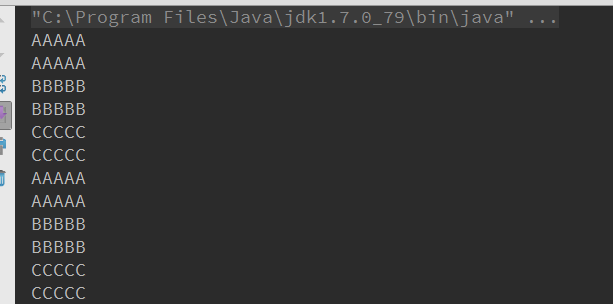Java指定线程执行顺序 Java实现指定线程执行顺序的三种方式示例
Leon-Zheng 人气:0本文实例讲述了Java实现指定线程执行顺序的三种方式。分享给大家供大家参考,具体如下:
方法一:通过共享对象锁加上可见变量来实现。
public class MyService {
private volatile int orderNum = 1;
public synchronized void methodA() {
try {
while (orderNum != 1) {
wait();
}
for (int i = 0; i < 2; i++) {
System.out.println("AAAAA");
}
orderNum = 2;
notifyAll();
} catch (InterruptedException e) {
e.printStackTrace();
}
}
public synchronized void methodB() {
try {
while (orderNum != 2) {
wait();
}
for (int i = 0; i < 2; i++) {
System.out.println("BBBBB");
}
orderNum = 3;
notifyAll();
} catch (InterruptedException e) {
e.printStackTrace();
}
}
public synchronized void methodC() {
try {
while (orderNum != 3) {
wait();
}
for (int i = 0; i < 2; i++) {
System.out.println("CCCCC");
}
orderNum = 1;
notifyAll();
} catch (InterruptedException e) {
e.printStackTrace();
}
}
}
import service.MyService;
public class ThreadAA extends Thread {
private MyService dbtools;
public ThreadAA(MyService dbtools) {
super();
this.dbtools = dbtools;
}
@Override
public void run() {
dbtools.methodA();
}
}
import service.MyService;
public class ThreadBB extends Thread {
private MyService dbtools;
public ThreadBB(MyService dbtools) {
super();
this.dbtools = dbtools;
}
@Override
public void run() {
dbtools.methodB();
}
}
import service.MyService;
public class ThreadCC extends Thread {
private MyService dbtools;
public ThreadCC(MyService dbtools) {
this.dbtools = dbtools;
}
@Override
public void run() {
dbtools.methodC();
}
}
import extthread.ThreadCC;
import service.MyService;
import extthread.ThreadAA;
import extthread.ThreadBB;
public class Run {
public static void main(String[] args) {
MyService myService = new MyService();
for (int i = 0; i < 2; i++) {
ThreadBB output = new ThreadBB(myService);
output.start();
ThreadAA input = new ThreadAA(myService);
input.start();
ThreadCC threadCC = new ThreadCC(myService);
threadCC.start();
}
}
}
执行结果:

可以看到线程的启动按顺序执行了。共享对象锁,可以保证每个方法只能同时有一个线程进入,配合wait和notifyall方法,可以启动或者唤醒线程。
方法二:通过主线程Join()
class T11 extends Thread {
public void run() {
System.out.println("in T1");
}
}
class T22 extends Thread {
public void run() {
System.out.println("in T2");
}
}
class T33 extends Thread {
public void run() {
System.out.println("in T3");
}
}
public class Test2 {
public static void main(String[] args) throws InterruptedException {
T11 t1 = new T11();
T22 t2 = new T22();
T33 t3 = new T33();
t1.start();
t1.join();
t2.start();
t2.join();
t3.start();
}
}
方法三:通过线程执行时Join()
class T1 extends Thread {
public void run(){
Random random = new Random();
try {
Thread.sleep(random.nextInt(1000));
} catch (InterruptedException e) {
e.printStackTrace();
}
System.out.println("in T1");
}
}
class T2 extends Thread{
private Thread thread;
public T2(Thread thread) {
this.thread = thread;
}
public void run(){
try {
thread.join();
} catch (InterruptedException e) {
e.printStackTrace();
}
System.out.println("in T2");
}
}
class T3 extends Thread{
private Thread thread;
public T3(Thread thread) {
this.thread = thread;
}
public void run(){
try {
thread.join();
} catch (InterruptedException e) {
e.printStackTrace();
}
System.out.println("in T3");
}
}
public class Test {
public static void main(String[] args) throws InterruptedException {
T1 t1 = new T1();
T2 t2 = new T2(t1);
T3 t3 = new T3(t2);
t2.start();
t1.start();
t3.start();
}
}
更多java相关内容感兴趣的读者可查看本站专题:《Java进程与线程操作技巧总结》、《Java数据结构与算法教程》、《Java操作DOM节点技巧总结》、《Java文件与目录操作技巧汇总》和《Java缓存操作技巧汇总》
希望本文所述对大家java程序设计有所帮助。
加载全部内容